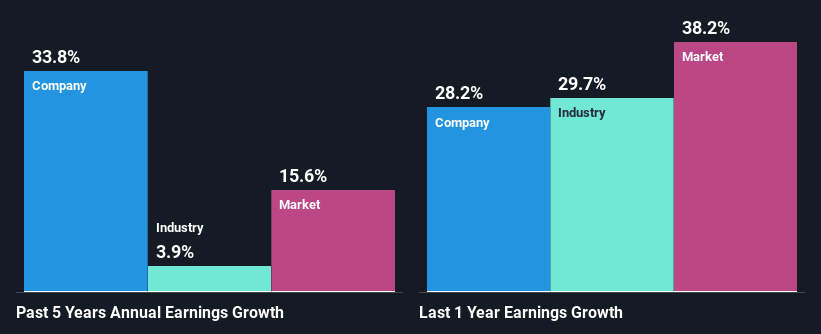Declining Stock and Solid Fundamentals: Is The Market Wrong About Richards Packaging Income Fund (TSE:RPI.UN)?
With its stock down 2.3% over the past week, it is easy to disregard Richards Packaging Income Fund (TSE:RPI.UN). But if you pay close attention, you might gather that its strong financials could mean that the stock could potentially see an increase in value in the long-term, given how markets usually reward companies with good financial health. Specifically, we decided to study Richards Packaging Income Fund's ROE in this article.
Return on equity or ROE is a key measure used to assess how efficiently a company's management is utilizing the company's capital. In other words, it is a profitability ratio which measures the rate of return on the capital provided by the company's shareholders.
See our latest analysis for Richards Packaging Income Fund
How To Calculate Return On Equity?
The formula for ROE is:
Return on Equity = Net Profit (from continuing operations) ÷ Shareholders' Equity
So, based on the above formula, the ROE for Richards Packaging Income Fund is:
27% = CA$45m ÷ CA$165m (Based on the trailing twelve months to June 2021).
The 'return' is the income the business earned over the last year. So, this means that for every CA$1 of its shareholder's investments, the company generates a profit of CA$0.27.
Why Is ROE Important For Earnings Growth?
So far, we've learned that ROE is a measure of a company's profitability. Depending on how much of these profits the company reinvests or "retains", and how effectively it does so, we are then able to assess a company’s earnings growth potential. Generally speaking, other things being equal, firms with a high return on equity and profit retention, have a higher growth rate than firms that don’t share these attributes.
Richards Packaging Income Fund's Earnings Growth And 27% ROE
Firstly, we acknowledge that Richards Packaging Income Fund has a significantly high ROE. Additionally, the company's ROE is higher compared to the industry average of 17% which is quite remarkable. As a result, Richards Packaging Income Fund's exceptional 34% net income growth seen over the past five years, doesn't come as a surprise.
Next, on comparing with the industry net income growth, we found that Richards Packaging Income Fund's growth is quite high when compared to the industry average growth of 3.9% in the same period, which is great to see.
Earnings growth is an important metric to consider when valuing a stock. The investor should try to establish if the expected growth or decline in earnings, whichever the case may be, is priced in. This then helps them determine if the stock is placed for a bright or bleak future. If you're wondering about Richards Packaging Income Fund's's valuation, check out this gauge of its price-to-earnings ratio, as compared to its industry.
Is Richards Packaging Income Fund Using Its Retained Earnings Effectively?
Richards Packaging Income Fund has a significant three-year median payout ratio of 55%, meaning the company only retains 45% of its income. This implies that the company has been able to achieve high earnings growth despite returning most of its profits to shareholders.
Additionally, Richards Packaging Income Fund has paid dividends over a period of at least ten years which means that the company is pretty serious about sharing its profits with shareholders.
Conclusion
On the whole, we feel that Richards Packaging Income Fund's performance has been quite good. Especially the high ROE, Which has contributed to the impressive growth seen in earnings. Despite the company reinvesting only a small portion of its profits, it still has managed to grow its earnings so that is appreciable. Up till now, we've only made a short study of the company's growth data. You can do your own research on Richards Packaging Income Fund and see how it has performed in the past by looking at this FREE detailed graph of past earnings, revenue and cash flows.
This article by Simply Wall St is general in nature. We provide commentary based on historical data and analyst forecasts only using an unbiased methodology and our articles are not intended to be financial advice. It does not constitute a recommendation to buy or sell any stock, and does not take account of your objectives, or your financial situation. We aim to bring you long-term focused analysis driven by fundamental data. Note that our analysis may not factor in the latest price-sensitive company announcements or qualitative material. Simply Wall St has no position in any stocks mentioned.
Have feedback on this article? Concerned about the content? Get in touch with us directly. Alternatively, email editorial-team (at) simplywallst.com.

